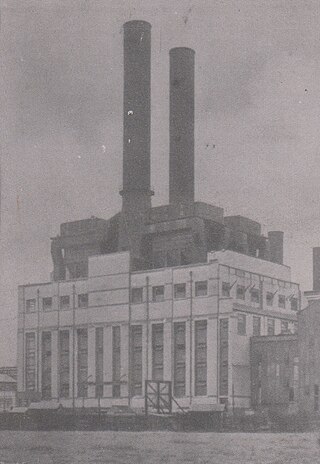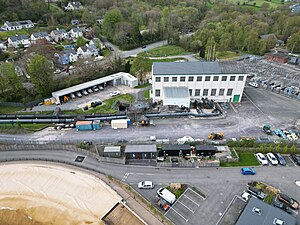
Llyn Cowlyd is the deepest lake in northern Wales. It lies in the Snowdonia National Park at the upper end of Cwm Cowlyd on the south-eastern edge of the Carneddau range of mountains, at a height of 330 metres (1,083 ft) above sea level. The lake is long and narrow, measuring nearly 3 kilometres (2 mi) long and about 500 m wide, and covers an area of 1.1 square kilometres. It has a mean depth of 33 metres (108 ft) and at its deepest has given soundings of 70 metres (230 ft), this being some 14 m (46 ft) greater than its natural depth, the water surface having been raised twice by the building of dams.

Wilford power station was a coal-fired electricity generating station situated on the north bank of the River Trent, at Nottingham in the East Midlands.

Dolgarrog is a village and community in Conwy County Borough, in Wales, situated between Llanrwst and Conwy, very close to the Conwy River. The village is well known for its industrial history since the 18th century and the Eigiau dam disaster, which occurred in 1925. The population was 414 at the 2001 Census, increasing to 446 at the 2011 Census. The community extends up to, and includes part of, Llyn Cowlyd in the Carneddau.

Cwm Dyli is the location of a hydro-electric power station on the southern flank of the Snowdon range in North Wales. At the time it was built, it was the largest hydro-electric power station in the United Kingdom. It is Britain's oldest power station, and is believed to be one of the oldest Grid-connected hydro-electric stations in the world.

Coedty Reservoir is a reservoir in Snowdonia, North Wales. It is fed by the waters of Afon Porth-llwyd which flows from Llyn Eigiau. The reservoir lies at a height of 900 feet (274 m), and measures some 12 acres (49,000 m2) in size. It contains brown trout.

Little Barford Power Station is a combined cycle gas turbine power station in the village of Little Barford in Bedfordshire, England. It lies just south of the A428 St Neots bypass and east of the Wyboston Leisure Park. The River Great Ouse runs alongside. It was formerly the site of two coal-fired power stations, now demolished. The station is operated by RWE.
Carmarthen Bay Power Station was an electricity power plant on the north shore of the Burry estuary in Wales in operation from 1953 to 1984.
Stourport power stations were two coal-powered electricity generating stations that supplied electricity to Stourport-on-Severn, Worcestershire and to the wider West Midlands area from 1927 to 1984. The two stations, A (1927–78) and B (1950–84), were collocated on a joint site adjacent to the River Severn south of Stourport-on-Severn.
The Percival Lane power station in Runcorn was built and operated by the Mersey Power Company Limited. It comprised two stations A and B commissioned in 1921 and 1941. The station supplied electricity to commercial, industrial and domestic users over a wide area of 95 square miles around the River Mersey including Widnes, Ellesmere Port and Runcorn.
The two Coventry power stations supplied electricity to the county borough of Coventry and the wider Warwickshire area from 1895 to 1976. They were owned and operated by Coventry Corporation until the nationalisation of the British electricity supply industry in 1948. The first power station was established in 1895 off Sandy Lane north of the city centre. A new larger power station was built at Longford / Hawksbury Junction in 1928 and was extended in 1938 and 1941. The Longford station was decommissioned in October 1976.
Maentwrog power station was built by the North Wales Power Company and supplied electricity to North Wales, Deeside and Cheshire. It exploits the water resources of the Snowdonia mountains, using water turbines to drive electricity alternators. The 24 MW station has been owned by several organisations; since 2004 it has been owned by the Nuclear Decommissioning Authority. It generates an annual electricity output of 60.6 GWh.
Machynlleth power stations were two small electricity generating stations in Machynlleth Powys. They provided electricity to the town and the surrounding rural district from 1938 until the 1970s. The A station was a combined diesel & hydro-electric plant and the B station was a diesel engine plant.
Nelson power station supplied electricity to the town of Nelson, Lancashire and the surrounding area from 1892 to 1960. The power station was owned and operated by Nelson Corporation prior to the nationalisation of the British electricity supply industry in 1948. It was redeveloped in 1922 to 1925 to meet the increased demand for electricity.
Stockport power station supplied electricity to the town of Stockport, Cheshire and the surrounding area from 1899 to 1976. The power station was owned and operated by Stockport Corporation prior to the nationalisation of the British electricity supply industry in 1948. It was redeveloped several times to meet the increased demand for electricity.
Southport power station supplied electricity to the town of Southport and the surrounding area from 1894 to the late 1960s. The power station was built by the Southport Corporation which operated it up to the nationalisation of the British electricity supply industry in 1948. Birkdale power station was operated by the Birkdale District Electric Supply Company Limited and originally supplied Birkdale Urban District until the district was incorporated into the Borough of Southport in 1911.
Tunbridge Wells power station supplied electricity to the town of Royal Tunbridge Wells and the surrounding area from 1895 to 1968. The power station was built by the Tunbridge Wells Corporation which operated it until the nationalisation of the British electricity supply industry in 1948.
The North Wales and South Cheshire Joint Electricity Authority supplied electricity to an extensive area of North Wales and parts of Cheshire and Shropshire. As constituted in 1923 the Joint Authority transferred all its rights to distribution of electricity in the area to the North Wales Power Company. The authority was effectively the power company. Both the joint authority and the power company were abolished in 1948 upon the nationalisation of the British electricity supply industry.
The British Power and Light Corporation Limited, also known as the British Power & Light Corporation (1929) Limited was registered in 1929 to acquire a controlling interest in electricity undertakings in North Wales; East Suffolk; South Somerset; Trent Valley and High Peak; West Hampshire; and Ringwood, Hampshire. The corporation operated for 19 years and was abolished upon the nationalisation of the British electricity supply industry in 1948.

The North Wales Hydro-Electric Power Act 1952 is an act of the Parliament of the United Kingdom which gave powers to the British Electricity Authority (BEA) to extend the hydro-electric stations at Dolgarrog and Maentwrog in North Wales and associated purposes.








